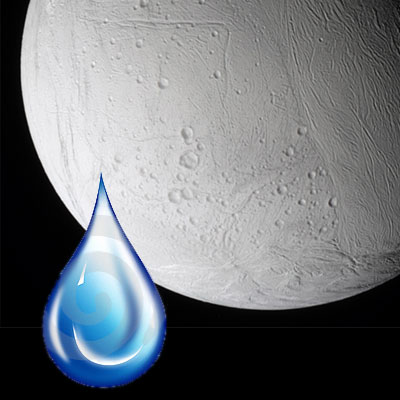 Put on your thinking caps, because it’s time for Science Friday! This week, we bring you a new Cassini Watch and Saturn’s southern cyclone, why “following the water” may not be enough for ET life, how a glass of shark’s blood a day keeps the doctor away, and mission status updates from the Mars Science Laboratory. All this plus our gadget of the week: the Objet Alaris30 3D printer makes like a Star Trek replicator.
Put on your thinking caps, because it’s time for Science Friday! This week, we bring you a new Cassini Watch and Saturn’s southern cyclone, why “following the water” may not be enough for ET life, how a glass of shark’s blood a day keeps the doctor away, and mission status updates from the Mars Science Laboratory. All this plus our gadget of the week: the Objet Alaris30 3D printer makes like a Star Trek replicator.
Cassini Watch: Inner Workings of the Saturn Cyclone
Star Trek‘s own Carolyn Porco and her team of imaging scientists on NASA’s Cassini mission have gotten a new glimpse of the monstrous vortex swirling over Saturn’s south pole. The new images sent back by the spacecraft are ten times more detailed than any seen before and are offering insights into the mechanisms that power the planet’s atmosphere. “What looked like puffy clouds in lower resolution images are turning out to be deep convective structures seen through the atmospheric haze,” said imaging team member Tony DelGenio. Further observations are planned between now and southern fall equinox in August 2009 to see how the features evolve as the seasons change from summer to fall. See the new images at http://ciclops.org.

A new Cassini image of Saturn’s southern cyclone
For Space, Water is Not Enough
NASA’s Astrobiology Institute has been using the mantra “follow the water” in its search for extraterrestrial life, but scientists are beginning to think that this may not be enough. Those taking a new approach plan to refine the criteria by characterizing life’s elemental requirements. “Water and energy are necessary but not sufficient,” says Ariel Anbar of Arizona State University’s School of Earth and Space Exploration. “Look at Earth. Nearly half the planet’s surface is covered by ocean regions in which life is scarce. The reason is that these regions don’t have high enough concentrations of the chemical elements necessary for life. So the next step in the search for life is to ‘follow the elements’.” The team will pursue a three-pronged research initiative to explore the relationship between the elemental composition of organisms and their environments, the impact of planetary processes on the abundance of bioessential elements, and the effects of astrophysical processes on the abundance of life-supporting elements.

Water alone is not enough for extraterrestrial life
Newest Cancer Treatment: Shark’s Blood!
Here’s an unorthodox way to help slow down the effects of cancer: a nice tall glass of shark’s blood. Sound gross? It is! But it also might just be effective. Sharks have immune systems similar to humans, but their antibodies – the molecules which actually fight disease – are exceptionally resilient. This means they would potentially be able to survive in the harsh environment of the human gut, which is crucial to the development of a cancer-fighting pill. Sharks were chosen for the project because they have robust immune systems and rarely succumb to infections. There is already evidence that their antibodies can slow the spread of breast cancer. But it is also hoped that they could eventually be used to treat other conditions, such as malaria and rheumatoid arthritis. More info…

Shark’s blood shows the potential to help fight cancer
NASA Moving Forward with Mars Science Laboratory
Following weeks of doubts about the future of the Mars Science Laboratory (MSL) — the one-ton, nuclear powered, laser-shooting next generation of Martian explorers — Lockheed Martin has shipped the vital “backshell” for the landing module, confirming that building is still under way. They also produced a video detailing the amazing landing procedure for the craft, during which a hovering “skycrane” lowers the rover to the ground before dutifully smashing itself into the surface a safe distance away.
New video of the future MSL at work on Mars
Gadget of the Week: Objet Alaris30 3D Printer Puts a Star Trek Replicator On Your Desk
3D printers are currently in use by industrial designers, many of whom have been happily using ultra-expensive real-life Star Trek replicators for years now. Yeah, cool, good for them, but when can we expect this technology in our homes? Considering the recent announcement of Objet’s Alaris30 3D desktop printer, that may not be so far off. The printer is no bigger than a regular printer/scanner combo, plugs into a regular power source, connects to any office network and ships with simple drivers and software that let your send CAD files to be produced from modeling plastic in dimensions up to 11.57 x 7.72 x 5.9 in. No price has been announced yet, but I’m not guessing this thing’ll be cheap. The video below shows some awesome results from the printer.
A plastic car made by the Alaris30 printer
Picture of the Week: An Odd Hill on Mars

An odd, solitary hill rising part-way down an eroding slope in Mars’ north polar layered terrain may be the remnant of a buried impact crater, suggests a University of Arizona planetary scientist who studied the feature in a new, detailed image from the HiRISE camera onboard NASA’s Mars Reconnaissance Orbiter. See more images at the HiRISE website.
Science Quickies
Here’s a warp-speed look at science tid-bits that didn’t quite make the cut, but nonetheless merit mention.
- Tech meets nature: microchips guard against cactus theft
- Einstein’s Relativity survives neutrino test
- Why Googling is good for your brain
- Phoenix Mars lander weathers Martian dust storm

Amazing how the picture of Saturn looks like a drop of water. I wonder if the shark’s blood would help me get rid of this cold? Bleah…….
Wow, that’s pretty cool about the shark’s blood!! Maybe transfusions will be possible?? I think I’m going too far into the realm of sci-fi now… XD
Why do they insist on following ‘life on earth’ when its highly probably there are other life forms not based on any chemistry we’re familiar with? Its the same thing with SETI..they are looking for radio signals from an alien race well *HELLO* unless they had a clone of Marconi its not likely they even have radios but something completely different. Maybe WE are the odd ones out and everyone else is using something we can even detect…oh my what a thought. How bloody arrogant human scientists are…*ANNOYED*
I <3 Science. There’s nothing like sharks to help with disease.
All right! Shark Week! Ever seen those videos of those great whites that jump outta the water near South Africa? That’s wicked badass cool!
What? It’s not Shark Week?
Oh.
yea why not just ignore what I said. no go ahead.
3. Shatners Bile Duct –
“Why do they insist on following ‘life on earth’ when its highly probably there are other life forms not based on any chemistry we’re familiar with? Its the same thing with SETI..they are looking for radio signals from an alien race well *HELLO* unless they had a clone of Marconi its not likely they even have radios but something completely different.”
Scientific technology progresses along fairly predictable avenues. It is completely logical to assume that an advanced civilazation other than ours would have at some point used radio waves to communicate over distances.
The real question is would they still be using such a fairly primitive method any longer? It’s difficult to imagine a highly advanced race (compared to us) still using such an archaic technology. If we picked up alien radio signals it would be coming from a civilization only roughly equal in technology to 20th century earth. But then the signals would likely be very, very old when we receive them so that civilization probably has advanced beyond the use of radio by the time we hear them.
7. Izbot –
3. Shatners Bile Duct –
Another reason for searching for signals similar to those used on earth is in finding extra-terrestrial life that is in some ways similar to us. It is quite likely that the universe is populated by a variety creatures, some so alien and different from us that neither side would have any commonalities at all — communication between us could be as impossible as trying to teach Shakespeare to a horse. Going from that assumption we should seek out life we could make meaningful contact with. Otherwise we could be inviting a superior lifeform to come exterminate us like we would an insect infestation.
3. Shatners Bile Duct –
And another point is that we only have our own knowledge to go on. It’s easy to look for what we know works. We understand radio waves, we use them, maybe others have figured this out as well.
Sure, some advanced race may use the equivilant of sub-space radio to communicate over distances — problem is we don’t know how it works or how to detect it.
It’s not arrogance at all, its simply looking for signals we already know how to detect.
#7, 8, 9 – Izbot
You sure you don’t have pointy ears and green blood? ;-)
10. Chingatchkook –
“#7, 8, 9 – Izbot
You sure you don’t have pointy ears and green blood? ;-)”
No, I have an art degree and do maintenance at a theatre for a living!
10. Chingatchkook –
…but my wife *does* have a degree in astrophysics.
OK, so Mars has a face ‘and’ a sphincter.
As for sharks, if they don’t take my blood I’ll try not to take theirs.
Thanks Kayla!!
Oh great now there is another reason to slaughter sharks to extinction
It’s bad enough that the Chinese and Japanese catch them only to slice of their fins and then toss them (still alive) back into the ocean to die an agonizing death for shark fin soup
then we had the supposed joint pain miracle cure of ground shark cartilage so more could be poached from the oceans to make ridiculous GNC snake oil
Now we have the holy grail of shark blood
The reimagined Trek 4 will likely be Kirk and Spock rescuing a pair of great whites instead of whales
I love sharks more than most people. Can we please leave them the F alone???
The MSL looks like one VERY complex piece of equipment, a thousand different little things to go wrong. Experience shows that simple, very proven tech is always the least fallible in these very long distance away missions. Just as the current successes on Mars have re-proven. I hope all goes well with it.
If the shark’s blood cure proves true, they’ll be extinct in 10 years time. Most shark species are already Threatened Species. It won’t take much to make them Endangered, then Extinct.
I would love to see the 3-D Printer (also known as ‘Fabrication’) in operation.
Great job as always Kayla. Still waiting to read about YOUR research.
The shark news in many respects is not news.
For centuries, the Chinese have been promoting the use of shark as cure for all kinds of diseases, with soup made from the cartilage of sharks as a treatment for cancer.
As far as western medicine is concerned, I remember reading articles in several different science journals where scientists were exploring treating cancer with products derived from sharks. What impressed the scientists most is that no matter how hard they tried to induce cancer to grow in sharks, particularly in their cartilage, they could not get it to grow.
Speaking of shark’s blood, on Star Trek did they ever say what animal Klingon blood wine came from?
@17 Tribbles?
@15 Commodore Lurker – If you really want to hear about my research (which tends to be boring sometimes) you can check out my website which has some abstracts from older projects, and a bit about what I’m working on now, which is studying Mt. Erebus, the most active volcano in Antarctica. I’ll be presenting my research in the spring, but hopefully I’ll be working on Antarctic stuff for a while; it’s really interesting!
http://www.theutensils.com/profile.html
Rock on, Kayla.
That MSL video was as beautiful and entertaining as a ballet. The cinema verite touches were nice too. I looked at it and marveled how we humans are both so incredibly advanced and amazing, and fragile and primitive as well.
Lurker, I had the same thoughts about it; but they’re doing things with it that usually require a well-equipped lab and scientists with hands and eyes and what-not. It’s hard to do that kind of science without a lot of moving parts. The landing sequence was the part that had me worried the most — and which was as cool as anything I’ve seen in a big-budget SF flick. :-)
Scott B. out.
19 Kayla, Wow thanks for the link! I’m a bit of an Antarctic geek myself. Very fascinating stuff indeed.
14. Lord Garth, Formerly of Sharkzar ,
Right on dude!
17. Joe Schmoe :
Actually, I think Blood Wine is from Targ blood. But, knowing Klingons the way we all do, I’m sure any dying thing on the way to Stovolkor will due.
21 Scott:
Yea, I agree the landing sequence on the MSL is dazzling, yet worrisome. I don’t understand why they didn’t use already proven techniques rather than trying something new and revolutionary on such an important and unique planetary lander. If it burns in to its doom, how long will it be before they can try again?????
How is this for a bizarre thing… I work for the Communications department of La Trobe University, we were the one who put out the ‘shark blood’ press release.
That story made it to a Star Trek website? It’s gone EVERYWHERE…
Heh, and I wasn’t even here looking for it…